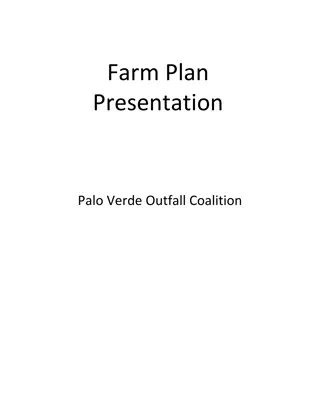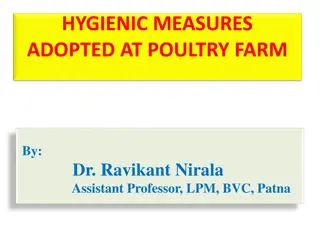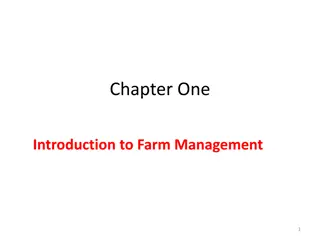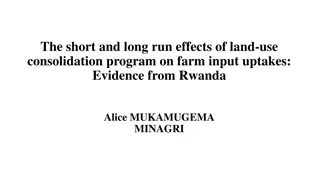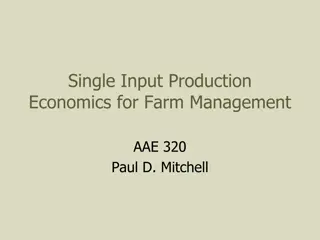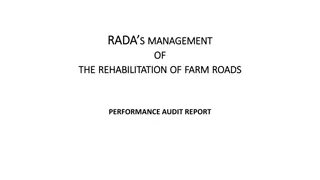Role of Farm Production in Child Diet Quality
A study explores the connection between family food production and child diet quality, focusing on the impact of child age and household wealth. Findings suggest that farm production is linked to children's intake, especially in poorer households and for older children. Dataset analysis from PoSHAN surveys highlights the role of farm production in improving child dietary diversity scores. The study spans diverse agro-ecological and socioeconomic conditions, underlining the importance of own-farm production in ensuring better nutrition outcomes for children.
Download Presentation

Please find below an Image/Link to download the presentation.
The content on the website is provided AS IS for your information and personal use only. It may not be sold, licensed, or shared on other websites without obtaining consent from the author.If you encounter any issues during the download, it is possible that the publisher has removed the file from their server.
You are allowed to download the files provided on this website for personal or commercial use, subject to the condition that they are used lawfully. All files are the property of their respective owners.
The content on the website is provided AS IS for your information and personal use only. It may not be sold, licensed, or shared on other websites without obtaining consent from the author.
E N D
Presentation Transcript
Farm production and child diets: Role of child age and household wealth Prajula Mulmi3, William A. Masters1, Shibani Ghosh1, Grace Namirembe1, Ruchita Rajbhandary2, Swetha Manohar2, Binod Shrestha2, Rolf Klemm2,3, Keith P. West, Jr2, Patrick Webb1 1 Friedman School of Nutrition Science & Policy, Tufts University 2 Bloomberg School of Public Health, Johns Hopkins University 3 Helen Keller International Selected paper for presentation at the annual meetings of the Agricultural and Applied Economics Association, 1 August 2017 Feed the Future Innovation Lab for Nutrition
Motivation Method Results Conclusions What is the link between a family s food production and their child s diet quality? There is now a large literature showing a positive link between what farm families grow and what their children consume o Especially for more remote households, further from food markets, who are more reliant on own production (e.g. Shibatu et al., 2015) We use two rounds of PoSHAN survey data (2013 & 2014) to test two key hypotheses about how and for whom production is linked to intake: 1) Is farm production linked to intake only for older children? Older children can consume the family diet, whereas infant feeding requires special care 2) Is farm production linked to intake only for poorer households? Poorer families may depend on their own farm, whereas richer ones can buy childrens food Outcomes are Diet diversity: whether child consumes 4 of 7 food groups Individual food groups: whether child consumes that food group
Motivation Method Results Conclusions Our sample spans a very wide range of agro-ecological and socioeconomic conditions Two rounds of household panel data (2013 2014) Representative of wards from the 21 VDCs Sampling strategy: SRS for VDCs and PPS for wards Data on: child and maternal nutrition, anthropometrics, diet diversity, food security, agricultural practices and types of food grown and marketed, and demographics Baseline report indicated n= 4,287 households with women= 4,509 and children under five 5,401 Manohar et al., 2014
Motivation Method Results Conclusions Does farm production raise intake only for the poor, as their lack of cash constrains access to markets? Child dietary diversity score (0-7) by wealth quintile Can own farm production fill this gap, for children in poorer households? Spoiler alert: the answer turns out to be yes Dataset: Policy and Science of Health, Agriculture, and Nutrition (PoSHAN) 2013 and 2014
Motivation Method Results Conclusions Does farm production raise intake only for older children, as they can consume the same as other family members? Child dietary diversity score (0-7) by age category Can own farm production fill this gap, for infants who need special care? Spoiler alert: the answer turns out to be no 6-23 months 24-59 months Dataset: Policy and Science of Health, Agriculture, and Nutrition (PoSHAN) 2013 and 2014
Motivation Method Results Conclusions Hypotheses, aims and potential significance Hypothesis: A household s own farm production is associated with more child diet diversity and intake of each food group, but only for children in poorer households only for children at older ages Aim: To identify mediating effects of household wealth and child age on the relationship between household food production and child dietary intake Implications: Evidence for these hypotheses would imply that: home garden and farm diversification programs could improve child diets mainly if targeted to the poorest in Nepal, and other programs would be needed to reach the youngest children.
Motivation Method Results Conclusion How is production diversity linked to diet diversity? Effect modifiers Agricultural production diversity Whether child meets minimum dietary diversity ( 4 of 7 food groups) Farmers vs. non-farmers Number of food groups grown (0-7) also have results using food species, not shown here
Motivation Method Results Conclusion How is production of each group linked to dietary intake of that group? Effect modifiers Production of each food group Intake of each food group Starchy staples Starchy staples Vitamin A-rich fruits & veg. Vitamin A-rich fruits & veg. Other fruits & vegetables Other fruits & vegetables Meat, fish, and poultry Meat, fish, and poultry Eggs Eggs Dairy Dairy Legumes, nuts and seeds Legumes, nuts and seeds
Motivation Method Results Conclusion How is production diversity linked to diet diversity? Statistical test: Logit with VDC and year fixed effects MDDCi = B0 + B1 farmdivih + B2 wealthih + B3 farmdivih X wealthih+ Zi + VDCi+ year + i Control variables: Maternal: Age, education, BMI Household: Caste, religion, land owned/rented Child: Sex, whether breastfed Geography: Altitude, ecological zone VDC and year fixed effects to absorb other characteristics of each place and time Outcome Variable: Whether child meets minimum dietary diversity ( 4) Mediating variable: Wealth quintile (1-5) Interaction term to test for mediation Farm production predictor variable: Food groups grown (0-7) Agricultural diversity quintile (0-5) Farmers vs. non-farmers (0 or 1)
Motivation Method Results Conclusion How is production of each group linked to dietary intake of that group? Statistical test: Logit with VDC and year fixed effects Cnsmptn ih = B0 + B1 prdctn ih+ B2 wealthih + B3 prdctn ih X wealthih + Zi + VDCi + year + i VDC and year fixed effects Outcome Variable: Consumption of each individual food group (from 1 to 7) Mediating variable: Wealth quintile (1-5) Control variables: Maternal: Age, education, BMI Household: Caste, religion, land owned/rented Child: Sex, whether breastfed Geography: Altitude, ecological zone Interaction term to test for mediation Farm production predictor variable: Production of that same food group (from 1 to 7)
Motivation Method Results Conclusion Household food production diversity is positively associated with child dietary diversity for older children in poorer households (1) (2) (3) (4) (5) MDDC 4 6-11 mo. MDDC 4 12-17 mo. MDDC 4 18-23 mo. MDDC 4 6-23 mo. MDDC 4 24-59 mo. Number of food groups grown (0-7) 0.183 (0.17) -0.086 (0.20) 0.430*** (0.13) 0.139 (0.10) 0.253*** (0.09) Quintile of household wealth (1-5) 0.218 (0.31) -0.034 (0.34) 0.786*** (0.20) 0.232 (0.18) 0.497*** (0.19) Wealth X number of groups grown -0.037 (0.05) 0.088 (0.07) -0.137*** (0.04) -0.030 (0.02) -0.039 (0.03) Controls Yes Yes Yes Yes Yes VDC & year fixed effects Observations Yes Yes Yes Yes Yes 396 399 800 1,635 4,343 Notes. Unit of observation is an individual child between 6-59 months. Standard errors in parentheses, clustered on VDCs. All results are from weighted logit regressions with fixed effects for each of 21 VDCs and 2 years. Survey weights are used for children in the balanced panel, in which each child is observed twice. The weights are 0.537 for Mountain, 1.711 for Hill and 0.834 for Terai. *** p<0.01, ** p<0.05, * p<0.1
Motivation Method Results Conclusion Results hold with the larger, unbalanced sample (1) (2) (3) (4) (5) MDDC 4 6-11 mo. MDDC 4 12-17 mo. MDDC 4 18-23 mo. MDDC 4 6-23 mo. MDDC 4 24-59 mo. Number of food groups grown (0-7) 0.083 (0.09) -0.131 (0.13) 0.335** (0.10) 0.052 (0.07) 0.166** (0.08) Quintile of household wealth (1-5) 0.211* (0.12) -0.070 (0.21) 0.559*** (0.21) 0.160 (0.11) 0.369** (0.18) Wealth X number of groups grown -0.031 (0.03) 0.093** (0.04) -0.096*** (0.03) -0.007 (0.02) -0.011 (0.03) Controls Yes Yes Yes Yes Yes VDC & year fixed effects Yes Yes Yes Yes Yes Observations 1,034 934 1,040 3,033 6,213 Notes. Unit of observation is an individual child between 6-59 months. Standard errors in parentheses, clustered on VDCs. All results are from weighted logit regressions with fixed effects for each of 21 VDCs and 2 years. Survey weights are used for children in the unbalanced panel. The weights are 0.449 and 0.504 for Mountain, 1.730 and 1.714 for Hill and 0.871 and 0.847 for Terai for panel 1 and 2, respectively. *** p<0.01, ** p<0.05, * p<0.1
Motivation Method Results Conclusion The link between farm production and child intake holds only for some food groups Coefficients on the association between individual food group production & consumption mediated by child age Production of: 6-11 mo. (cons.) 12-17 mo. (cons.) 18-23 mo. (cons.) 6-23 mo. (cons.) 24-59 mo. (cons.) Vitamin A-rich F&V 0.71 0.61 1.24*** 0.98*** 0.45 Other F&V 1.16 0.50 0.73 0.56 1.08*** Meat 1.83 -1.76 0.87 0.12 0.21 Eggs 0.78 0.22 1.64*** 1.32*** 0.98*** Dairy -1.71*** -0.49 0.98*** 0.06 1.20*** Legumes, nuts & seeds 0.08 0.47 -0.36 0.03 0.63 Observations 396 399 800 1,635 4,343 Notes. Unit of observation is an individual child between 6-59 months.. All results are from weighted logit regressions with fixed effects for each of 21 VDCs and 2 years. Survey weights are used for children in the balanced panel. The weights are 0.537 for Mountain, 1.711 for Hill and 0.834 for Terai. *** p<0.01, ** p<0.05, * p<0.1
Motivation Method Results Conclusion The link between home production and intake holds only for specific food groups, among older and poorer children For Vitamin A-rich F&V child intake is positively associated with household production only for older children in poorer households. The same holds for other F&V except that richer households do not feed more other F&V at any age. 6-11 mo. (cons.) 12-17 mo. (cons.) 18-23 mo. (cons.) 6-23 mo. (cons.) 24-59 mo. (cons.) Vitamin A-rich F&V HH produces this group HH wealth HH prod. X wealth Other Fruits & Vegetables HH produces this group HH wealth HH prod. X wealth Observations 1.24*** 0.18* -0.27* 0.98*** -0.21** 1.20** -0.15* 1.08*** -0.24* 4,343 396 399 800 1,635 Notes: Coefficients not significantly different from zero are not shown, and coefficients on control variables are also omitted. Unit of observation is an individual child between 6-59 months.. All results are from weighted logit regressions with fixed effects for each of 21 VDCs and 2 years. Survey weights are used for children in the balanced panel. The weights are 0.537 for Mountain, 1.711 for Hill and 0.834 for Terai. *** p<0.01, ** p<0.05, * p<0.1
Motivation Method Results Conclusion The link between home production and intake holds only for specific food groups, among older and poorer children For Dairy, child intake is positively associated with household production only for older children in poorer households. The same holds for Eggs, except that richer households feed more eggs at all ages. 6-11 mo. (cons.) 12-17 mo. (cons.) 18-23 mo. (cons.) 6-23 mo. (cons.) 24-59 mo. (cons.) Dairy HH produces this group HH wealth HH prod. X wealth Eggs HH produces this group HH wealth HH prod. X wealth Observations 0.98*** 0.36*** -0.28** 1.23*** 0.42*** -0.26*** 1.64*** 0.15* 1.32*** 0.27*** 0.98*** 0.21*** 0.68*** 0.37** 396 399 800 1,635 4,343 Notes: Coefficients not significantly different from zero are not shown, and coefficients on control variables are also omitted. For dairy, anomalous results for 6-11 month olds are also omitted. Unit of observation is an individual child between 6-59 months.. All results are from weighted logit regressions with fixed effects for each of 21 VDCs and 2 years. Survey weights are used for children in the balanced panel. The weights are 0.537 for Mountain, 1.711 for Hill and 0.834 for Terai. *** p<0.01, ** p<0.05, * p<0.1
Motivation Method Results Conclusions Summary of findings Agricultural production diversity and child dietary diversity is: Positively associated but only for older children (18 or 24 mo.) Positively associated but in poorer households (lowest one or two quintiles) Individual food group production and consumption is: Positively associated for older children at all levels of wealth only for eggs Positively associated for older children at lower levels of wealth for fruits and vegetables, and dairy
Motivation Method Results Conclusions Implications of the findings Farm-diversifying programs aimed at improving child dietary diversity will likely see benefits only after 18 months of age Improving dietary quality of younger children will require other kinds of complementary feeding interventions For older children, maximum benefits of these interventions can be seen when poorer households that are further from markets are targeted Except for eggs, production of food groups such as fruits and vegetables and dairy and its consumption are mediated by wealth
Categorization of food items consumed by a child into food groups as per FAO FAO food groups Food items listed in 7-day food frequency questionnaire+ Lito, rice, corn, wheat, millet, potato Starchy staples Dark Green Leafy Vegetables (DGLVs) Dark Green Leafy Vegetables (DGLVs) Vitamin A rich fruits and vegetables Carrots, pumpkin, drumstick, ripe mango, ripe jackfruit and ripe papaya Gundruk, green beans, green peas, gourd, okra, eggplant, green jackfruit, tomato, cauliflower, cabbage, guava, orange, apple, pineapple and banana Chicken, duck, goat, buff, pork, fish and snails Egg Milk and curd Daal, maseura, legumes and peanuts Other fruits and vegetables Flesh foods (meat, fish and poultry) Eggs Dairy (milk and milk products) Legumes, nuts and seeds
Categorization of crops and livestock produced by households for food FAO Food groups Crops and livestock produced for food Starchy staples Barley, buckwheat, finger millet, maize, potatoes, rice, sorghum, wheat, cassava, taro, and yam Green leaves Dark Green Leafy Vegetables (DGLVs) Vitamin A rich fruits and vegetables Sweet potatoes, carrots, drumstick, mango, melon, papaya, and pumpkin Banana, peas, apple, avocado, green beans, berries, bitter gourd, cabbage, capsicum, cauliflower, bottle gourd, chili, cucumber, eggplant, guava, lemon, lychee, okra, onions, orange, pineapple, peach, plum, radish, sponge gourd, squash, tomato, other fruit and vegetables Cattle, buffalo, ox, cow, yak, goat, poultry, sheep, pigs, and fish ponds Poultry, guinea, fowls and pig Other fruits and vegetables Flesh foods (meat, fish and poultry) Eggs Dairy (milk and milk products) Cattle, buffalo, ox, cow, yak, goat, and sheep Legumes, nuts and seeds Beans, chickpeas, groundnut, lentils, oil seeds, soybeans, and sunflower
Distribution of food species grown Dataset: Policy and Science of Health, Agriculture, and Nutrition (PoSHAN) 2013 and 2014
Results also control for altitude and zone Source: www.mof.gov.np
NLSS: Determining market participation NLSS District-level means: 1) Value of food purchased in markets 2) Value of food obtained in donations 3) Value of food produced in household farms We compute: District's average share of food consumption that is purchased or donated (market use): (1+2/ 1+2+3) o High market use districts = above or equal median market use o Low market use =below median of market use
Motivation Method Results Conclusion Economic model of farm households Time allocated for farming Food production Farm households Time allocated for child care Access to markets Possess purchasing power Consumption needs fulfilled Child care needs not fulfilled Source: de Janvry et al., 1991; Foster and Rosenzweig, 2010; Eswaran & Kotwal, 1989; Bardhan & Udry, 1999
Motivation Method Results Conclusion Economic model of farm households Time allocated for farming Food production Farm households Time allocated for child care Access to markets Possess purchasing power Consumption needs fulfilled Child care needs not fulfilled Source: de Janvry et al., 1991; Foster and Rosenzweig, 2010; Eswaran & Kotwal, 1989; Bardhan & Udry, 1999
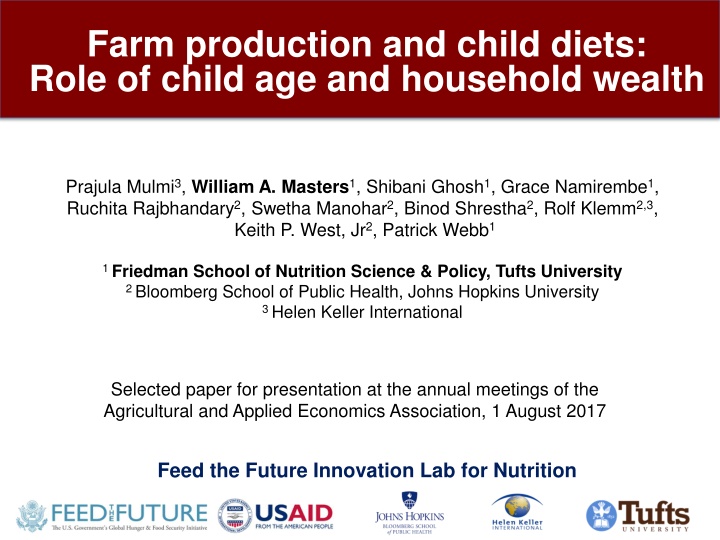

![READ [PDF] Dash diet Cookbook for beginners: 365 days of simple, healthy, low-s](/thumb/2057/read-pdf-dash-diet-cookbook-for-beginners-365-days-of-simple-healthy-low-s.jpg)



